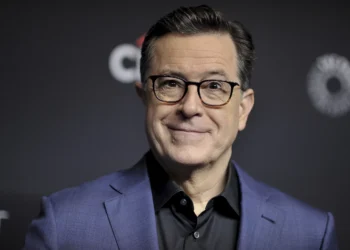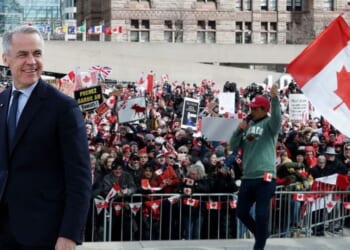If President Donald Trump takes the unprecedented step of trying to fire Fed Chairman Jerome Powell, the effort would roil markets and likely be met with pushback in the courts.
Trump and the Trump administration have increasingly turned their fire on Powell and his leadership of the central bank. Much of the ire stems from Powell and the Federal Open Market Committee’s repeated decisions to not lower interest rates.
Trump and his allies contend that interest rates are too high and that they are stifling the economy and economic growth. But Fed officials argue that inflation is still too high and that lowering rates could cause another wave of inflation that would be painful to quash.
The Fed has a dual mandate: price stability and maximum employment. Interest rates are the main tool in the central bank’s toolbox. Typically, if inflation is too high, it raises its interest rate target in order to limit overall spending and curb inflation pressures.
Unlike the Treasury Department and other government agencies, the Fed is independent from the executive, meaning that Trump doesn’t have direct control over what it does.
But now that independence might be tested as Trump and others reportedly mull an attempt to remove Powell from the position he has held since 2018.
The backdrop
Trump himself nominated Powell, who has a long background in banking and is a wealthy former businessman, to serve as Fed chairman. His nomination sailed through the Senate in a bipartisan 84-13 vote in 2018.
But the honeymoon soon ended during Trump’s first term when Powell began raising interest rates to maintain price stability. By late 2018, Trump was bashing the chairman on social media.
“The only problem our economy has is the Fed,” Trump tweeted. “They don’t have a feel for the Market, they don’t understand necessary Trade Wars or Strong Dollars or even Democrat Shutdowns over Borders.”
The rhetoric ratcheted up even further, and in 2019, Trump notoriously wrote that his “only question is, who is our biggest enemy,” Powell or Chinese leader Xi Jinping.
Then came the pandemic, which sent shockwaves through the global financial system and prompted the Fed to take the unprecedented step of cutting interest rates to near-zero and holding them there for two years.
Then, driven in part by the low interest rate environment and rebound from the lockdowns, the economy exploded back, and inflation ticked to the highest levels in decades, causing a new economic crisis.
Powell was renominated to the role by former President Joe Biden to oversee the response to the inflation and began hiking interest rates in 2022. After bringing down the rate of inflation, the Fed began cutting rates last year. In recent months, though, inflation has remained stubbornly above the Fed’s 2% goal, and some at the central bank have worried that tariffs could generate upward price pressures. As a result, Powell has held back from further rate cuts.
Prior to his tenure at the Fed, Powell, a graduate of Georgetown Law, went into investment banking. He worked in the Treasury Department under former President George H.W. Bush in the 1990s. After that he spent nearly a decade as a partner at Carlyle Group, one of the biggest private equity firms in the U.S.
The push
Trump swept into office last year, largely driven by voter discontent with inflation and Biden’s handling of the economy. The Fed had a scheduled meeting the day after the election and opted to lower rates by a quarter of a percentage point.
But since then, the Fed has had five more meetings where it opted to hold rates steady. Trump has gotten more hostile to Powell during that time. The president has taken to branding the Fed chairman with the nickname “Too Late” and has bashed him repeatedly on his social media platform Truth Social.
This week, officials at the White House confirmed to the Washington Examiner that Trump has started asking Republican lawmakers about firing Powell — a move that has never been taken by a sitting president and one that would cause massive blowback and a legal challenge.
A firing appeared imminent this week, with financial markets falling in response. But then in what appeared to be a reversal, Trump said in the Oval Office that an attempt to remove Powell was not happening for now.
“He’s doing a lousy job, but no, I’m not talking about that,” Trump said in comments to the press. “Fortunately, we get to make a change in the next, what, eight months, and we’ll pick somebody that’s good.”
Around the same time, Office of Management and Budget Director Russ Vought has been ratcheting up pressure, and in a letter, accused Powell of having “grossly mismanaged” the central bank. He used the $2.5 billion renovations at the Fed headquarters as an example of Powell’s mismanagement and lack of oversight.
The response
On his end, Powell has largely played the whole situation cool. He has not waded into an open war in the press over the matter, but has repeatedly said that he doesn’t believe that Trump has the legal authority to fire him.
This is a position that Powell has long held. In November, right after the election, Powell was asked whether he would resign if asked.
“Not permitted under the law,” Powell responded.
Even further, while testifying on Capitol Hill, Powell said he would not leave even if Trump moved to fire him.
“It doesn’t occur to me in the slightest that there would be any situation in which I would not complete my term other than dying,” Powell told a reporter, according to the book Trillion Dollar Triage.
But that isn’t stopping the push against Powell from the Trump administration. This week, Powell responded in writing to the probe from Vought over the renovations at the Fed headquarters. Powell said that he will ask the Fed’s independent inspector general to conduct a “fresh review” of the project.
Pitchforks have also come out for Powell on Capitol Hill. Rep. Anna Paulina Luna (R-FL), one of Powell’s harshest critics, said this week that she is “criminally referring” Powell to the Justice Department over the renovation.
Still, other lawmakers would likely balk at such a move, given how the Fed is supposed to be independent from the White House.
“The Federal Reserve needs to remain independent, I feel strongly about that,” Rep. Mike Flood (R-NE) told the Washington Examiner this week, noting that he too wants interest rate relief. “But we’ve got to trust this system we have and an independent central bank has to be able to make decisions and react in real time to what’s happening.”
Users on Kalshi, the first government-regulated exchange dedicated to trading on the outcome of future events, show the odds of Powell being ousted as Fed chairman by the end of the year at about 1 in 4. Meanwhile, competitor Polymarket has the odds pegged at 22%, up from just 12% at the start of June.
What would happen if he fired Powell?
If Trump moved to fire Powell, there would be a big legal backlash, especially considering the indications that Powell would fight back.
Some also speculate that the recent probe into the Fed headquarters could be an effort to oust the Fed chief. For instance, during Trump’s remarks, he said that it was unlikely he would fire him but hinted at the Fed renovation.
“Unless he has to leave for fraud, I mean, it’s possible there’s fraud involved with the $2.5, $2.7 billion renovation,” Trump said.
According to the Federal Reserve Act of 1913, a Fed chairman can only be removed for “cause.”
Peter Conti-Brown, a Fed historian at the University of Pennsylvania, told the Washington Examiner this week that he thinks that Trump’s advisers might have “ginned up a controversy” to provide the “cause” needed to oust him.
“But that very animus and pretext will be the reasons why their effort will not succeed as a legal matter,” Conti-Brown added over email. “If ‘for cause’ protection stands for anything, it stands for the idea that the president cannot simply invent a reason for that removal.”
If Trump moves to fire him, Powell could sue to be reinstated, and the case could make its way to the Supreme Court.
TRUMP CALLS POWELL ‘ONE OF MY WORST APPOINTMENTS’ AND SLAMS BIDEN FOR REAPPOINTING HIM
The push is also unlikely to influence Powell and the Fed to lower interest rates. Powell, a seasoned businessman, is unlikely to yield to the pressure that Trump and his allies are exerting right now. He is also unlikely to move in the opposite direction, according to Mark Hamrick, senior economic analyst at Bankrate.
“Ultimately, I think the President’s actions and words are counterproductive, because if anything, I don’t think that there’s going to be an equal and opposite reaction on the part of, let’s say, Jerome Powell and his colleagues in essentially becoming more adamantly against interest rate cuts, but it’s not productive,” Hamrick told the Washington Examiner.















